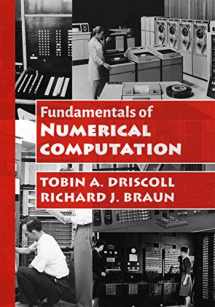
Fundamentals of Numerical Computation
Book details
Summary
Description
Fundamentals of Numerical Computation is an advanced undergraduate-level introduction to the mathematics and use of algorithms for the fundamental problems of numerical computation: linear algebra, finding roots, approximating data and functions, and solving differential equations. The book is organized with simpler methods in the first half and more advanced methods in the second half, allowing use for either a single course or a sequence of two courses. The authors take readers from basic to advanced methods, illustrating them with over 200 self-contained MATLAB functions and examples designed for those with no prior MATLAB experience. Although the text provides many examples, exercises, and illustrations, the aim of the authors is not to provide a cookbook per se, but rather an exploration of the principles of cooking.
Professors Driscoll and Braun have developed an online resource that includes well-tested materials related to every chapter. Among these materials are lecture-related slides and videos, ideas for student projects, laboratory exercises, computational examples and scripts, and all the functions presented in the book.
The authors describe their goals and intentions for the book in specific terms: Our guiding point of view is that the student users of the book are far more likely to apply and remix fundamental computational algorithms than to reinvent them. We want to prepare them for more advanced courses in numerical analysis, but we place a higher priority on conveying foundational skills in scientific computation. Accordingly, we emphasize knowing how to cast a problem into a form that can be coded and solved, tradeoffs between different methods for a problem, and assessing the correctness and convergence of the results. We do not, however, make much of an issue of optimizing the speed of implementations, except when orders of magnitude are in play, nor do we discuss parallelism.
Above all, we emphasize linear algebra. Linear algebra is the lingua franca of scientific computing a fact in no small measure established and affirmed by MATLAB over more than three decades."
Audience: Fundamentals of Numerical Computation is intended for advanced undergraduates in math, applied math, engineering, or science disciplines, as well as for researchers and professionals looking for an introduction to a subject they missed or overlooked in their education.
Contents: Prologue: Two Imperfect Ideas; Chapter 1: Numbers, Problems, and Algorithms; Chapter 2: Square Linear Systems; Chapter 3: Overdetermined Linear Systems; Chapter 4: Roots of Nonlinear Equations; Chapter 5: Piecewise Interpolation and Calculus; Chapter 6: Initial-Value Problems for ODEs; Chapter 7: Matrix Analysis; Chapter 8: Krylov Methods in Linear Algebra; Chapter 9: Global Function Approximation; Chapter 10: Boundary-Value Problems; Chapter 11: Diffusion Equations; Chapter 12: Advection Equations; Chapter 13: Two-Dimensional Problems; Appendix A: Review of Linear Algebra.


We would LOVE it if you could help us and other readers by reviewing the book
Book review



